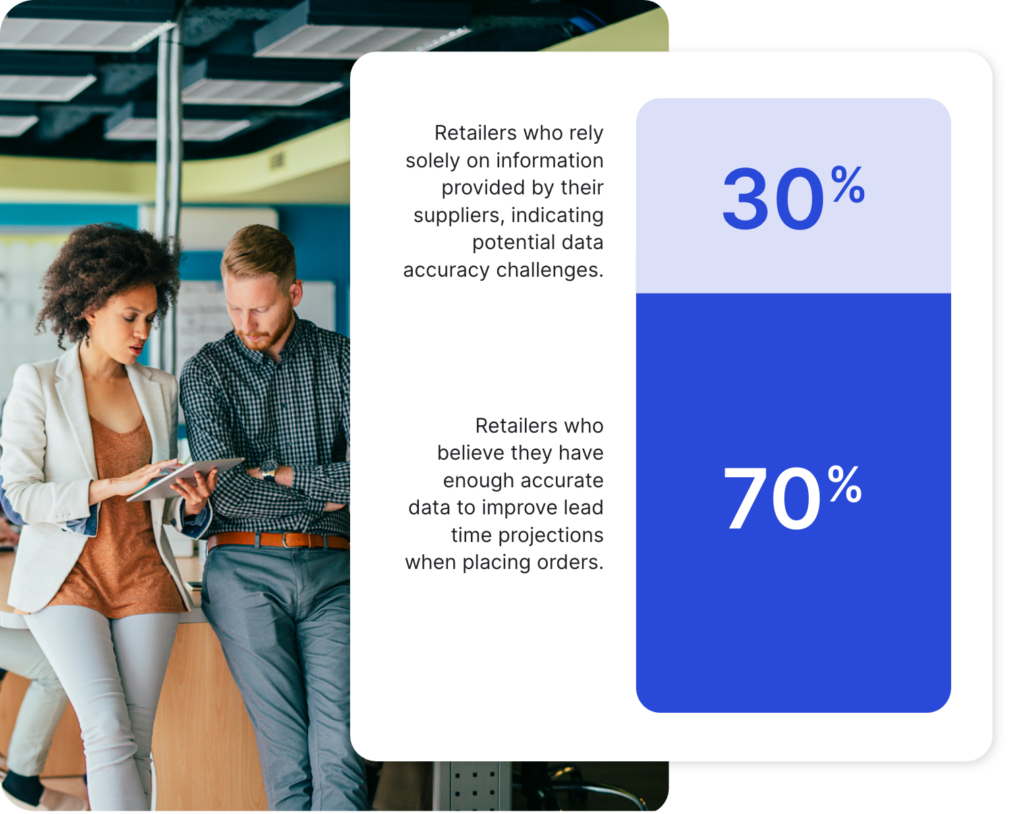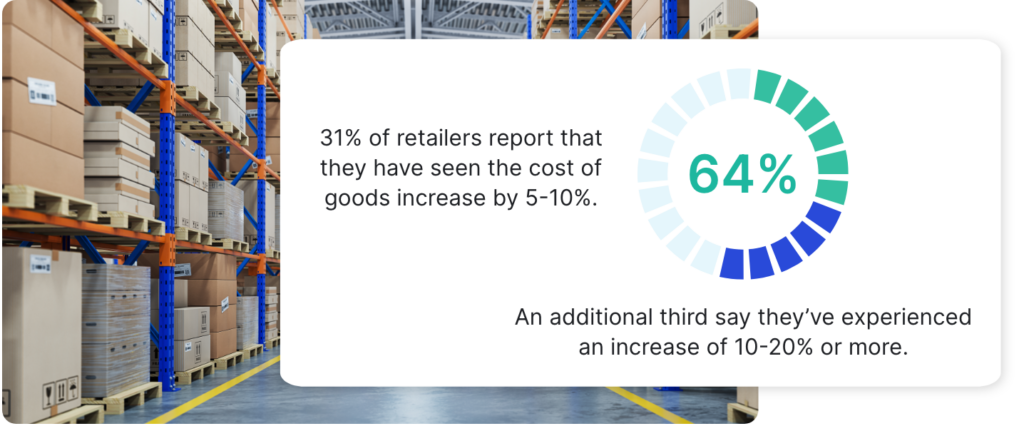Optimizing Supply Chains for the Holiday Shopping SurgeRetailers’ Strategies for Black Friday & Cyber Monday
Black Friday and Cyber Monday (BCFM) are significant milestones in the retail calendar, serving as critical periods for brands to capitalize on consumer demand and drive sales. As the retail industry prepares for the holiday surge, efficient supply chain management is essential to ensure success.
Recently, Anvyl surveyed 300 retailers to shed light on the current state of their BFCM plans. This report presents a comprehensive analysis of their supply chain preparations leading up to this peak shopping event, uncovering the strategies, challenges, and innovations brands employ to optimize supply chain performance.
Through the analysis of the findings, this report aims to answer key questions such as:
- How prepared are retailers to meet consumer demand this BFCM?
- What are the lead times for brands to get inventory in their hands?
- How will economic challenges, like inflation, impact profit projections?
- What other challenges are threatening to impact performance this BFCM?
- What strategies are retailers implementing to improve supply chain efficiency?
Here’s what we found.
Retailers Delay Inventory Planning
According to our survey, 83% of retailers report that the global economy has forced them to make adjustments to their ordering quantities and/or be more hesitant when placing orders for Black Friday and Cyber Monday inventory.
Economic uncertainties, such as fluctuations in exchange rates, trade tensions, and supply chain disruptions, have compelled retailers to carefully assess their inventory needs and exercise caution in their procurement decisions. In response, retailers are seeking to strike a balance between avoiding excess inventory and ensuring they have sufficient stock to meet demand during BFCM.
Additionally, our survey reveals that the timeline for inventory preparation among respondents varied, but 33% of brands plan to begin as late as September. The best time to initiate inventory preparation for BFCM depends on various factors, including the size of your business, the type of products you sell, and your supply chain capabilities. But starting in September raises concerns about the potential risks and challenges brands may face. It provides a limited timeframe to ensure optimal inventory levels, align supplier lead times, and address any unforeseen disruptions.
In order to optimize supply chain efficiency, it is recommended that brands initiate inventory preparation no later than July, although some retailers like to start as early as April by analyzing the previous year’s sales data. Beginning preparations several months in advance will allow them to:
- Respond better to demand fluctuations: Early preparation provides more time to adjust inventory levels based on market trends and consumer demands, reducing the risk of stockouts or excess inventory.
- Secure competitive prices from suppliers: Starting early allows brands to negotiate better deals with suppliers, potentially securing more favorable pricing and terms.
- Mitigate inventory shortage risks: By initiating preparations early, brands can identify potential supply chain disruptions and take proactive measures to avoid inventory shortages during the critical BFCM period.
Minimize last-minute challenges: Early preparation enables smoother logistics planning, reducing the likelihood of shipping delays or other unforeseen issues.
Data Inaccuracies Threaten Lead Times
Nearly 65% of respondents expect inventory to arrive in their warehouses two to four weeks before BFCM. This timeframe would allow retailers to ensure efficient logistics, proper inventory management, and ample time for quality control checks and product preparations.
This highlights the need for accurate lead time projections. If their lead time projections fail, it will leave them open to disruptions that could impact the availability of their products during BFCM. This requires having the proper amount of insights.
Approximately 70% of retailers believe they have enough accurate data to improve lead time projections when placing orders. However, ~30% rely solely on information provided by their suppliers, indicating potential data accuracy challenges.

Relying on supplier data may expose retailers to risks such as delays, unexpected demand fluctuations, or mismatched projections and actual inventory availability. To optimize inventory planning, invest in data-driven tools and establish transparent communication channels with suppliers to enhance lead time projections and minimize supply chain uncertainties.
Cost of Goods Impacting Profits
31% of retailers report that they have seen the cost of goods increase by 5-10% this year. An additional third say they’ve experienced an increase of 10-20% or more.

It’s unsurprising that a majority are hesitant to place orders for BFCM. Persistent challenges and volatility in the global economy have led to higher production costs, transportation expenses, and raw material expenses. This cost inflation may impact retailers’ profit margins during BFCM, causing them to rethink their pricing strategies. It may also affect their overall competitiveness in the market, as they face the task of balancing increased expenses while remaining price-competitive.
Retailers need to manage costs effectively to maintain competitiveness and customer loyalty. This includes locking in shipping capacity and rates. 66% of brands say they plan to lock in shipping capacity and rates in July and August. This is a positive sign that most are proactively securing favorable shipping arrangements.

Retailers that opt to lock in shipping capacity and rates in September may face higher shipping costs or limited carrier options, potentially affecting delivery timelines and customer satisfaction. Such delays or cost overruns could also impact the overall profitability of their Black Friday and Cyber Monday sales.
To overcome these challenges, brands should:
- Conduct regular cost analysis
- Explore strategic partnerships with suppliers
- Negotiate long-term agreements to stabilize costs and improve budget predictability.
- Plan to lock in shipping capacity and rates no later than August
Demand Forecasting Struggles Cast Shadow on BFCM Plans
85% of retailers are at least somewhat concerned about inventory shortages during BFCM.
Brands’ fears are warranted, reflecting the importance of having adequate product availability to meet the overwhelming consumer demand that characterizes these peak shopping periods. An inventory shortage would jeopardize performance, leading to missed sales opportunities, overrun customer service teams, and long-term damage to brand reputation.
It also represents a Catch-22. Supply chain teams are apprehensive about placing orders due to the rise in the cost of goods, but they’re also worried they won’t have enough stock to meet demand. Adding to the paradox, our previous research shows 66% of brands are currently overstocked months in advance of the holiday sales. This suggests retailers are struggling with demand forecasting leading up to BFCM, accumulating too much stock that isn’t in demand and not enough inventory for popular products.
Adding to these complexities: 80% of retailers plan to introduce new products in support of BFCM. While exciting for customers, this poses challenges for supply chain teams to manage additional SKUs and demand variations effectively. Brands need to collaborate closely with product development and marketing teams to align launch plans with supply chain capabilities, ensuring successful product introductions.
Brand Aggregators Share Successful BFCM Strategies
Brand aggregators represent a unique business model in which a company purchases and then brings together multiple products or ecommerce brands under a single umbrella. Some brand aggregators focus on specific product categories or platforms such as Amazon or Shopify.
Black Friday Cyber Monday (BFCM) represents exponentially more risk and potential upside for brand aggregators managing a portfolio of brands versus focusing on a single brand. For the purposes of this report, we spoke to Supply Chain Managers at several brand aggregators about their strategies to ensure their BFCM promotions reach the right shoppers at the right time.
According to another brand aggregator, BFCM success relies heavily on inventory effectiveness and close partnership with suppliers as well as their internal marketing and product development teams. Introducing a new product to the market during the holidays can also be difficult. That’s why it’s important to build a footprint and potential events leading up to help drive rankings, reviews, and sales.
Critical to the success of the brand aggregators we interviewed, brands should focus on having transparency and a strong tech stack allowing them to:
- Review historical lead times to understand the true capabilities of suppliers
- Clearly communicate with suppliers utilizing engagement metrics tracked over time
- Change your shipping method or split shipments to get ahead of inventory issues
- Bring together data from other systems to understand trends from a macro perspective
Brands Diversifying Supply Chain Tech Stack to Mitigate Risks
63% of retailers are actively exploring new suppliers or sourcing regions to reduce the impact of potential disruptions. This is a persistent trend, and one we’ve previously explored in past studies.
Improved Communication with Suppliers (71%)
Streamlined Order Fulfillment Processes (49%):
Demand Forecasting Tools (46%):
Supply Chain Automation (45%):
While an integrated approach is important, the data shows that more than half of retailers are lagging behind when it comes to adopting the tools needed to optimize supply chain performance, enhance agility, and ultimately ensure a successful BFCM. As many struggle with inventory planning and demand forecasting, increased investment in a diversified tech stack could help them build a stronger and more profitable BFCM strategy.
Conclusion
Proactive preparation is key for a successful Black Friday and Cyber Monday. In many ways, retailers are implementing a range of strategies to optimize operations, enhance supply chain resilience, and meet consumer expectations. However, they’re also exercising caution as fears surrounding a bad economic climate grow.
The insights presented in this report serve as a roadmap for informed decision-making and operational excellence during the forthcoming Black Friday and Cyber Monday events. By staying agile, proactive, and customer-focused, retailers can seize opportunities, mitigate challenges, and unlock success in the competitive retail environment.